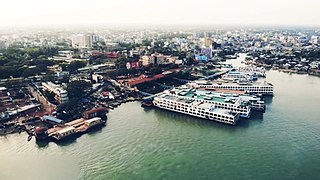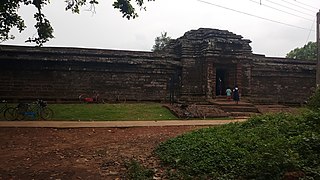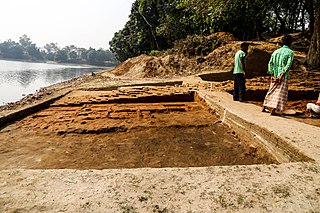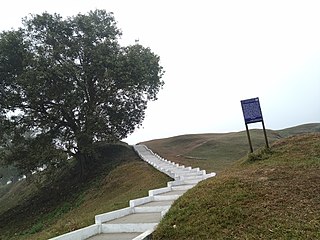
Gaṅgaikoṇḍa Chōḻapuram is a village located near to Jayankondam, Ariyalur district, Tamil Nadu, India. It became the capital of the Chola dynasty in c. 1025 by Chola emperor Rajendra I, and served as the capital for around 250 years.

Mahasthangarh is one of the earliest urban archaeological sites discovered thus far in Bangladesh. The village Mahasthan in Shibganj upazila of Bogra District contains the remains of an ancient city which was called Pundranagara or Paundravardhanapura in the territory of Pundravardhana. A limestone slab bearing six lines in Prakrit in Brahmi script recording a land grant, discovered in 1931, dates Mahasthangarh to at least the 3rd century BCE. It was an important city under the Maurya Empire. The fortified area was in use until the 8th century CE.

Naogaon District is a district in northern Bangladesh, part of the Rajshahi Division. It is named after its headquarters, the city of Naogaon in Naogaon Sadar Upazila.

Gauḍa is a historic city of Bengal in the eastern part of the Indian subcontinent, and one of the most prominent capitals of classical and medieval India, being the capital city of Bengal under several kingdoms. The Gauḍa region was also a province of several pan-Indian empires. During the seventh century, the Gour Kingdom was founded by King Shashanka, whose reign corresponds with the beginning of the Bengali calendar. Gour gradually became synonymous with Bengal and Bengalis. It was conquered by Bakhtiyar Khalji, a lieutenant of the Ghurid ruler Muhammad of Ghori in 1203.

Barisal, officially known as Barishal, is a major city that lies on the banks of the Kirtankhola river in south-central Bangladesh. It is the largest city and the administrative headquarter of both Barisal District and Barisal Division. It is one of the oldest municipalities and river ports of the country. The city was once called the Venice of the East or the Venice of Bengal.

The Architecture of Bengal, which comprises the modern country of Bangladesh and the Indian states of West Bengal, Tripura and Assam's Barak Valley, has a long and rich history, blending indigenous elements from the Indian subcontinent, with influences from different parts of the world. Bengali architecture includes ancient urban architecture, religious architecture, rural vernacular architecture, colonial townhouses and country houses and modern urban styles. The bungalow style is a notable architectural export of Bengal. The corner towers of Bengali religious buildings were replicated in medieval Southeast Asia. Bengali curved roofs, suitable for the very heavy rains, were adopted into a distinct local style of Indo-Islamic architecture, and used decoratively elsewhere in north India in Mughal architecture.

The Wari-Bateshwar ruins in Narsingdi, Dhaka Division, Bangladesh is one of the oldest urban archaeological sites in Bangladesh. Excavation in the site unearthed a fortified urban center, paved roads and suburban dwelling. The site was primarily occupied during the Iron Age, from 400 to 100 BCE, as evidenced by the abundance of punch-marked coins and Northern Black Polished Ware (NBPW) artifacts.

Burrough Hill is an Iron Age hillfort in Burrough on the Hill, 7 miles (11 km) south of Melton Mowbray in the English county of Leicestershire. Situated on a promontory about 210 metres (690 ft) above sea level, the site commands views over the surrounding countryside for miles around. There has been human activity in the area since at least the Mesolithic, and the hillfort was founded in the early Iron Age. In the medieval period, after the hillfort was abandoned, the hill was used as farmland. This ended in the 17th century when the parish the hill was in was enclosed. Traces of ridge and furrow show where the medieval fields were ploughed. Since the 1930s the site has been the subject of archaeological investigations and renewed excavations under the auspices of the University of Leicester began in 2010. Part of Burrough Hill Country Park and open to the public, the hillfort is protected as a Scheduled Ancient Monument.

Unguja Ukuu is a historic Swahili settlement on Unguja island, in Zanzibar, Tanzania.

The Kurumbera Fort is a medieval fort situated in Gaganeshwar village, southeast of Keshiari, at about four kilometres from that town. The fort has small quarters and temples. It is a protected monument under the Archaeological Survey of India.

Srivijaya archaeological park, formerly known as Karanganyar archaeological site, is the ancient remnants of a garden and habitation area near the northern bank of Musi river within Palembang vicinity, South Sumatra, Indonesia. Remnants of ancient man-made canals, moats, ponds and artificial islands discovered in this area suggests the site was related with a 9th-century settlement related to the Srivijaya empire. Several artifacts, such as Buddhist statues, beads, pottery and Chinese ceramics were found in this area, confirming the area was once a dense human habitation.

Tel Michal is an archaeological site on Israel's central Mediterranean coast, near the modern city of Herzliya, about 6.5 kilometres (4.0 mi) north of the Yarkon River estuary and 4 kilometres (2.5 mi) south of Arsuf-Appolonia. Excavations have yielded remains from the Middle Bronze Age to the Early Arab period.

Bhitargarh is an archaeological site that includes the remains of an ancient fort city built in and around the 5th century AD. It is located in Panchagarh District in Rangpur Division in the northern part of Bangladesh and is large enough that it can be seen from space. The archaeological significance of the site lies in its strategic position as an intersection of the trade routes between Tibet, Nepal, Bhutan and the middle and lower Ganges Valley. At its height the city stretched over 5 km by 3 km and involved rerouting the Talma River.

Warangal Fort is located in Warangal District, Telangana, India. It was the capital city of Kakatiya dynasty and the Musunuri Nayakas. It appears to have existed since at least the 12th century when it was the capital of the Kakatiyas. The fort has four ornamental gates, known as Kakatiya Kala Thoranam, that originally formed the entrances to a now ruined great Shiva temple. The Kakatiyan arch has been adopted and officially incorporated into the emblem of Telanganaafter the bifurcation of Andhra Pradesh. The fort is included in the "tentative list" of UNESCO World Heritage Site and was submitted by the Permanent Delegation of India to UNESCO on 10/09/2010.

Pundranagar in Paundrabhukti was the most important city in the ancient Bengal region, now identified with the current site of Mahasthan, located in Bogra, Bangladesh. It was a vibrant administrative, religious and cultural centre from the 3rd century BC to the 12th century AD that is from the Maurya Empire time to the Sena dynasty period. Archaeological remains and literary descriptions speak of a truly planned and magnificent city. City walls, elaborate gates, palaces, common dwellings, assembly halls, temples, viharas, shops, ponds and even suburban temples and viharas characterised the city; Chinese pilgrim, Xuanzang, visiting in the 7th century AD, particularly mentions ponds, orchards, flowers and pleasure gardens.

Gomsi is an ancient archaeological site located between Rani Village and Sika Tode in East Siang District, Arunachal Pradesh, India. It is dated to the 13th-14th century by the Directorate of Research, Government of Arunachal Pradesh and is associated with the Chutia Kingdom. It is located at the field of Rani Village, about 15 km from the town of Pasighat.
The Kasturi Rangappa Nayaka Fort in Sira in Tumkur district of Karnataka is named after the Nayaka ruler Kasturi Rangappa Nayaka, who had ruled over Sira in the early 17th century as a palegar under the Vijayanagar Empire. After their rule, the fort and the Province of Sira came under the control of several rulers. Restoration works have been carried out by the Archaeology Department of Karnataka.
Bambata Cave is one of the Southern Africa prehistoric sites situated in Motobo National Park along with Inanke, Nswatugi, Pomengwe and Silozwane caves in Zimbabwe.
The Fisher Mound Group is a group of burial mounds with an associated village site located on the DesPlaines River near its convergence with the Kankakee River where they combine to form the Illinois River, in Will County, Illinois, about 60 miles southwest of Chicago. It is a multi-component stratified site representing several Prehistoric Upper Mississippian occupations as well as minor Late Woodland and Early Historic components.

Rajpat or Kamtapur Fort is an archaeological site in present-day Gosanimari in the Dinhata I CD block in the Dinhata subdivision of the Cooch Behar district in West Bengal, India.

![Engraved vessel fragments of Sena period recovered from Debalgarh. deblgdd' theke uddhaarkRt senyuger u[?]kiirnn mR[?]paatrer ttukr smuuh.jpg](http://upload.wikimedia.org/wikipedia/commons/thumb/d/d8/%E0%A6%A6%E0%A7%87%E0%A6%AC%E0%A6%B2%E0%A6%97%E0%A6%A1%E0%A6%BC_%E0%A6%A5%E0%A7%87%E0%A6%95%E0%A7%87_%E0%A6%89%E0%A6%A6%E0%A7%8D%E0%A6%A7%E0%A6%BE%E0%A6%B0%E0%A6%95%E0%A7%83%E0%A6%A4_%E0%A6%B8%E0%A7%87%E0%A6%A8%E0%A6%AF%E0%A7%81%E0%A6%97%E0%A7%87%E0%A6%B0_%E0%A6%89%E0%A7%8E%E0%A6%95%E0%A7%80%E0%A6%B0%E0%A7%8D%E0%A6%A3_%E0%A6%AE%E0%A7%83%E0%A7%8E%E0%A6%AA%E0%A6%BE%E0%A6%A4%E0%A7%8D%E0%A6%B0%E0%A7%87%E0%A6%B0_%E0%A6%9F%E0%A7%81%E0%A6%95%E0%A6%B0_%E0%A6%B8%E0%A6%AE%E0%A7%82%E0%A6%B9.jpg/250px-thumbnail.jpg)
















